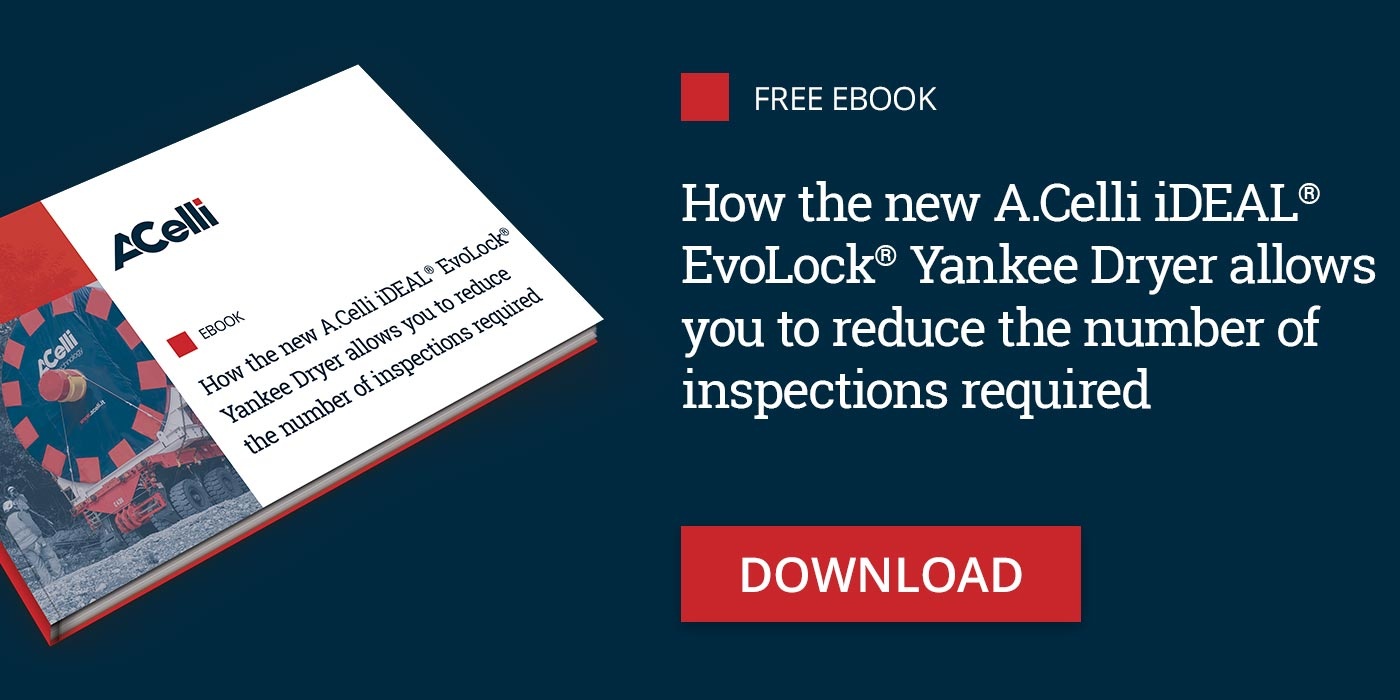As regards the structural design of the Yankee Dryer, the components involved are, mainly, the shell and the type of coupling provided between the heads and the shell itself. The common construction solutions for the shells use the assembly technique by welding several rolled plates; weldings are also used by several manufacturers to join the heads to the shell.
Due to their very nature, structural welds are always associated with a certain level of risk, the minimization of which involves compliance with rigorous and onerous periodic inspection protocols to which the Yankee Dryers must be subjected. Thanks to A.Celli, these risks and the related management costs can be eliminated through the use of highly innovative construction techniques.
Welded or forged shell: the main differences
The shell of a steel Yankee Dryer is traditionally built with the welding technique, which involves the following main phases:
- Calendering of steel plates
- Union of these plates by means of circumferential and longitudinal welds to form the cylinder;
- Coupling of heads and shell by means of two circumferential welds, also these with full penetration;
- Total and local heat treatments for stress relief due to calendering and welding
- Machining of all the pieces until reaching the desired profiles and final dimensions.
The welds in question, during the operation of the Yankee, are subjected to intense cyclic stress. This is why it is necessary to regularly inspect them by means of checks that can be both visual and performed with the aid of more sophisticated tools, in order to highlight the onset and propagation of cracks. They range from common tests with penetrating liquids (PT), to ultrasound tests (UT) up to Acoustic Emission testing (AET), especially after an abnormal incident. Most of these checks must be performed from inside the Yankee Dryer, leading to additional downtime required for its cooling and reheating.
To overcome these problems, A.Celli has developed steel Yankee Dryer equipped with a forged monobloc shell obtained from a single steel ingot. Its manufacturing process involves the following steps:
- Heating of the ingot to a temperature of over 1200 ° C;
- Pre-forging of a toroidal monoblock starting from the ingot;
- Circular hot-rolling until reaching the diametrical dimension and thickness necessary for the raw artifact;
- Thermal treatments
The result is an isotropic shell of homogeneous material with very high shape stability and and without welds that does not require periodic checks and does not present deformation problems, both during the processing phase and during use under varying operating pressure and temperature conditions.
Head-to-shell coupling: alternatives to welding
When coupling the heads with the shell, usually, full penetration structural welds come into play that join and seal the two parts, guaranteeing the necessary safety that allows the Yankee to work with internal pressures up to 11 bar. These welds also require the same periodic checks already seen for the shell in order to verify its integrity or the presence of any cracks.
An alternative that does not require welding, conceived by A.Celli, is the one implemented in the Yankee Dryer iDEAL® Forged YD, where the coupling between heads and forged shell takes place by means of bolts. This eliminates the welds between head and shell and the related inspections, with a significant saving in terms of time and costs.
A traditional steel Yankee Dryer with a welded shell and heads that are also welded to the shell must undergo an internal visual inspection every year, an ultrasonic weld inspection after the first two years of operation and, subsequently, an ultrasonic inspection every five years. For a Yankee Dryer with bolted heads, on the other hand, TAPPI recommends a UT bolt inspection every 5 years, with significantly lower costs in terms of inspections.
To further reduce the number of necessary inspections and the resulting additional downtime of the line, A.Celli has devised a new, innovative system for coupling the shell with the heads that will be fitted to the new Yankee Dryers of the EvoLock® family.
A.Celli iDEAL® EvoLock®: no welds or bolts
If the coupling of heads and shell required the use of one or more structural welds, in the case of traditional Yankee Dryers, or bolts, in the case of the iDEAL® Forged YD, A.Celli has been able to overcome both these systems by developing a new coupling method that does not use structural welds or screws, implemented in the new Yankee Dryer iDEAL® EvoLock®.
This system makes it possible to enormously reduce the downtime of the line necessary to complete the necessary inspections, even compared to the previous iDEAL® Forged YD, thus allowing to obtain a significant increase in productivity without sacrificing either the quality of the product obtained or the intrinsic safety of the Yankee cylinder.
Do you want to know how all this is possible and how much time dedicated to the various inspections could you save? Download our free eBook “How the new Yankee Dryer A.Celli EvoLock® allows you to reduce the number of inspections required”.

